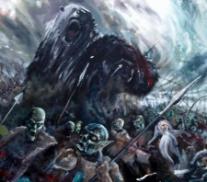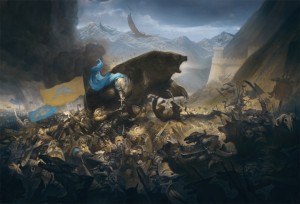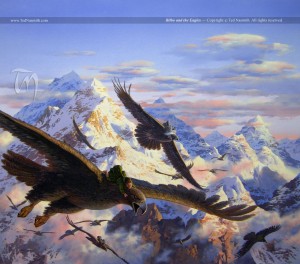The Battle of the Five Armies
 ’The Clouds Burst’ is the chapter where the main battle takes place – it is also the one in which we are given the second reference to army numbers. For the moment, let us focus on the Wargs and Goblins. As they approach, Gandalf bursts out shouting:
’The Clouds Burst’ is the chapter where the main battle takes place – it is also the one in which we are given the second reference to army numbers. For the moment, let us focus on the Wargs and Goblins. As they approach, Gandalf bursts out shouting:
“‘Behold! The bats are above this army like a sea of locusts. They ride upon wolves and Wargs are in their train!’”
It cannot be argued that at the Battle, both Goblins and Wargs far outnumbered the other three armies. The various descriptions that are associated with them give us approximate clues to their numbers. We are no longer talking about the few hundreds of Lake-town men or Dwarves under Dáin. Here, these two evil armies almost definitely would have numbered in their thousands.
“… in all the mountains there was a forging and an arming … a vast host was assembled.”
The word host is mentioned again, but with a slightly different meaning to that associated with the Elven army. Here, we are given an extra detail, another word to describe to us the army’s size — vast. Once again, it is made clear that thousands would have gathered on the day of the battle and as it is about to commence, we read: “… the Mountain’s feet black with a hurrying multitude.”
Tolkien wanted to reach the climax of The Hobbit by using the idea of an epic battle fought against two extreme sides and with two distinct purposes. One of them as a way to bring forth the theme of greed, and on the other, present to us the theme of friendship and alliance — fighting together for a common good. Further on, Tolkien delves into the strategic and tactical movements of the armies and amongst the words, we come to the second reference to army numbers (albeit a small one).
“As soon as the host of their enemies was dense in the valley, they [Elves] sent against it a shower of arrows … a thousand of their spearmen leapt down and charged.”
So what is certain is that over five hundred Dwarves and one thousand Elves took part in the Battle of Five Armies. To understand the true meaning of the above quote, one has the re-read it carefully and with attention. “a thousand of their spearmen”, paraphrased differently would literally mean: “a portion of the army’s spearmen”. In my opinion, that implies that the Elven army, at the very least, was divided into two: archers and spearmen. The archers were positioned to weaken the attack of the goblins whilst the spearmen would defend or attack. Going back to the phrase: “a thousand of their spearmen”, it seems to mean that out of a couple of thousand elves, one thousand of these where the first to engage in the fighting.
“… a host of Wargs came ravening …”
Returning back to the evil armies, it is made clear to us that not only the goblins were in large numbers, but also their allies, the Wargs. Furthermore, out of such a “terrible battle” it would be impossible not to have casualties.
“… among the goblin dead lay many men and many dwarves, and many a fair elf …”
 This quote states that both sides lost large portions of their armies -– especially the goblins. We have already discussed the idea of a vastly superior force by part of the goblins during the battle, and this is soon confirmed in the following quote:
This quote states that both sides lost large portions of their armies -– especially the goblins. We have already discussed the idea of a vastly superior force by part of the goblins during the battle, and this is soon confirmed in the following quote:
“Songs have said that three parts of the goblin warriors of the North perished on the day.”
As the surviving armies go back to their homelands we are told:
“The elf-host was on the march … sadly lessened.”
Although losing much of its strength the Elven army is still being referred to as a host -– it would make sense then to think that before the battle it had been quite a large force (thousands) and having lost many after the battle, it still remained fairly big.
The eagles and the aftermath of the battle
Although not part of the ‘five’ armies, the eagles play an important role in the battle. It seems, at first, that even these creatures came with quite a large force:
“The eagles were coming down the wind, line after line, in such a host as must have gathered from all the eyries of the North.”
Line after line, host, all the eyries all describe the coming of a strong force but we might be getting the wrong impression that there were many eagles. One may find a very important quote in The History of the Hobbit (Volume 1) –- specifically, Chapter VI: ‘Wargs and Eagles’:
“Given that Tolkien’s continued interest in the eagles, it is odd that in the Battle of the Five Armies the wargs and goblins each count as a ‘people’ for purposes of the tally yet the eagles do not. Perhaps there are simply too few eagles present to be described as an ‘army’ (as seems to be the case with Beorn) …”
So the fact that the Eagles aren’t considered as one of the armies would imply that the force wasn’t as big as one is made to believe -– and this may easily apply to all the other ‘established’ armies.
How many fought at the battle? And how many fell?
 Turning back to the matter of the size of the goblins (excluding the wargs, for it seems certain that for each goblin to participate in the battle, there would have been an equivalent warg for travelling purposes), I think it would be good if we were to go back in time a couple of years before the battle itself.
Turning back to the matter of the size of the goblins (excluding the wargs, for it seems certain that for each goblin to participate in the battle, there would have been an equivalent warg for travelling purposes), I think it would be good if we were to go back in time a couple of years before the battle itself.
I am assuming that the orcs present at the Battle of Five Armies came from the various colonies in the Misty Mountains (as told in The Hobbit) and the North, including Mount Gundabad and Moria. If we are able to understand from past histories what happened after the Battle of Azanulbizar, we might be able to perceive whether orcs were able to multiply in huge numbers over a short period of time. Though it is important to note that here we aren’t given any army numbers (which is the whole purpose of this discussion), but at the very least, we can make out how large the goblin army was at the Battle.
From various quotes in the appendices of The Lord of the Rings, we can deduce that the orcs were almost completely destroyed at the Battle of Azanulbizar, leaving the Misty Mountains free from their evil. But just after 142 years, the orcs renewed their forces and launched the attack on the Lonely Mountain. Here, as is described in The Hobbit, three-parts of the orcs of the North, were destroyed that day. Once again, the North became free of their evil for many years. Within 48 years after the Five Armies battle, Balin returned to Moria and was lost (2989 TA). By that time the orc numbers grew and, as we are told in The Fellowship of the Ring, the Company of the Ring was attacked by them.
This points towards one conclusion: that the goblins could have easily multiple within a few years and attacked in a strong force during the Quest for Erebor. With that, this article concludes all the analysis by giving out estimate figures of the size of the armies present at the Battle. (Please note, numbers are approximations only, based purely on speculation for the above quotes).
Battle of the Five Armies by the numbers
Size of forces before the battle
Elves 2,000
Men 300
Dwarves 550
Eagles 50
Goblins and wargs 25,000
Size of forces after the battle
Elves 900
Men 100
Dwarves 350
Eagles 20
Goblins and wargs 0
References:
The Hobbit
The Lord of the Rings: The Return of the King
The History of Middle Earth (Volumes 1 and 2)
The Atlas of Middle Earth
TORn staffer Arandir loves reading books, writing (no books yet – though I hope, one day) and watching films (who doesn’t, really?). He has a very cool blog called A Tolkienist’s Perspective where he regularly analyses and discusses Tolkien’s works. The views presented in this article are his own and don’t necessarily represent TheOneRing.net or other staff.


